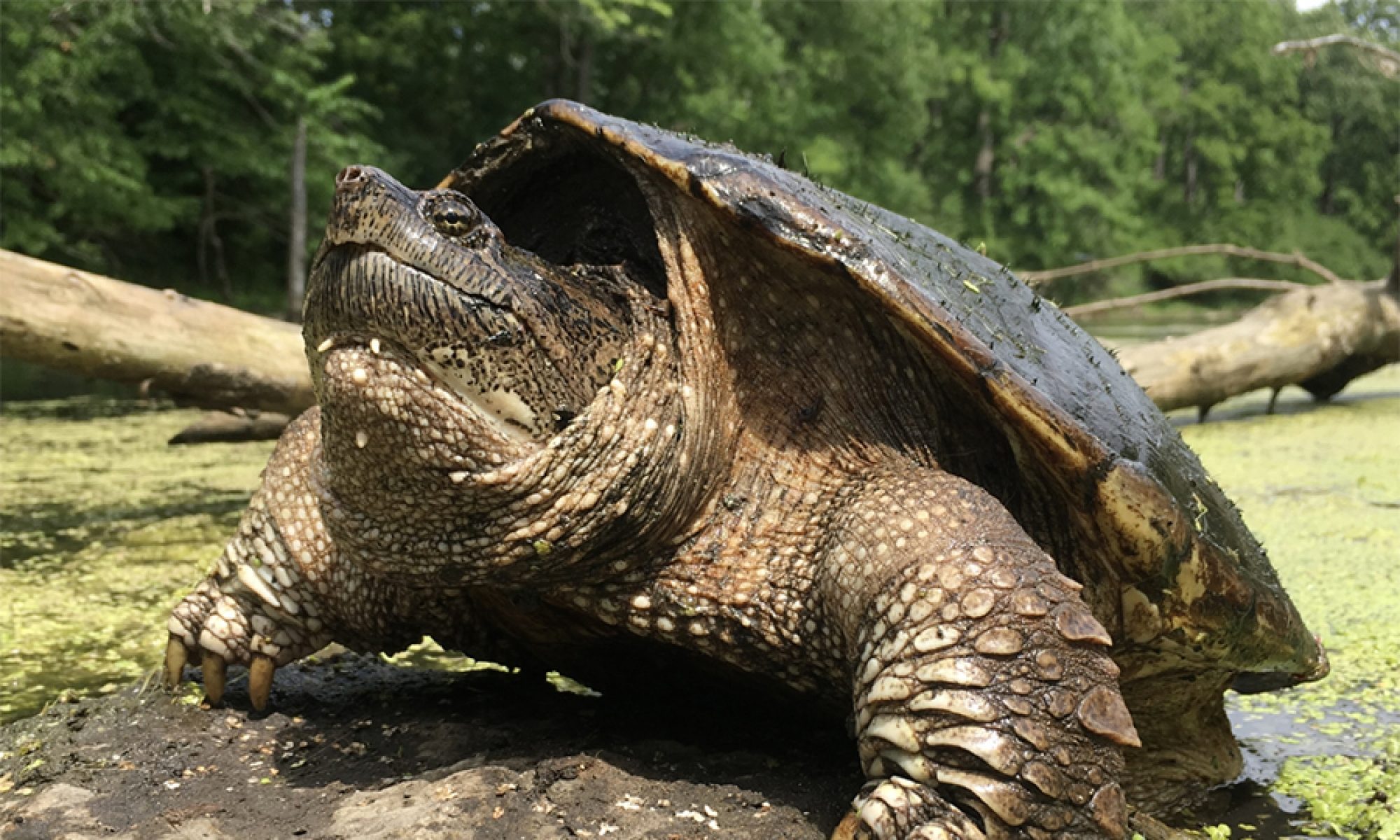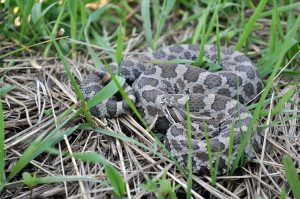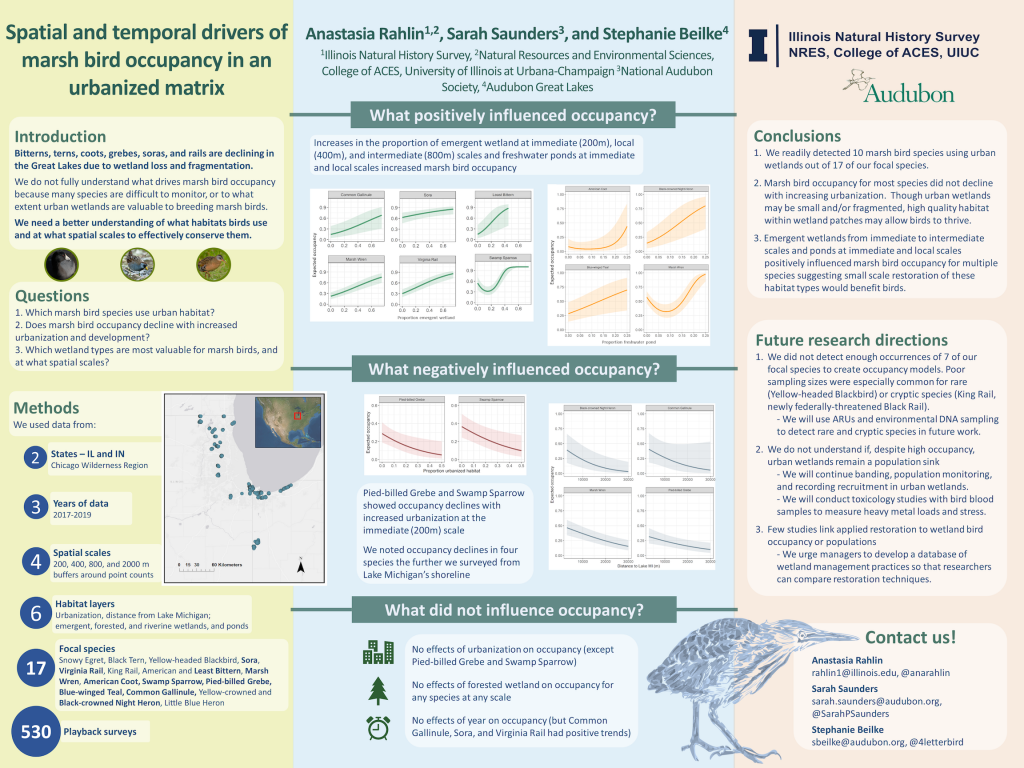The infamous John Rucker Turtle Dogs have returned to Illinois this spring to and have garnered a lot of media attention. INHS PaCE Lab M.Sc. student Andrea Colton has been there, searching for, collecting data, and marking the turtles. Check out some of the media stories and Andrea’s slideshow:
Massasauga hibernacula at Carlyle Lake are genetically distinct units
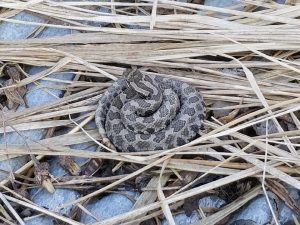 Genetic analysis shows that the Eastern Massasauga hibernacula at Carlyle Lake are genetically distinct units.
Genetic analysis shows that the Eastern Massasauga hibernacula at Carlyle Lake are genetically distinct units.
Once found across the northern two-thirds of Illinois, populations of the Eastern Massasauga have declined, with only one known population remaining in Illinois. Our long term studies have found the top four sources of mortality to include automobiles, predation, management related mortality (prescribed burns, mowing, etc), and disease. Our current study indicates that efforts to address these ecological threats may not be enough to save this imperiled species.
The area under what is now known as Carlyle Lake was a floodplain valley known as Boulder Bottoms. The creation of Carlyle Lake in the 1960s flooded this area, separating habitats on the the east and west sides of the Kaskaskia River, pushing wildlife, including the Eastern Massasauga, to the edges between the lake and agricultural fields. These bands of habitat are separated by the lake, paved roads, agriculture, and urbanization, potentially limiting migration and gene flow between patches.
Our current study looked at 327 genetic samples collected between 1999 and 2015 from individuals at 9 hibernacula across 3 study areas at Carlyle Lake. Study sites separated by up to 5 km had limited gene flow, as did hibernacula separated by a few hundred meters. This restriction of gene flow increases the vulnerability of these already imperiled populations.
Our study indicates that conservation and recovery efforts need to consider genetic rescue efforts in addition to reduction of ecological threats. Such efforts may include translocations and captive rearing to reduce the impacts of inbreeding depression and genetic drift. Even short distance translocations between the different study areas at Carlyle Lake could help restore gene flow impeded by contemporary human created fragmentation.
Read the paper at PLOS One
Seeking a PhD student to study Eastern Massasauga
We are seeking an individual with a keen interest and desire to develop applied research aimed at conserving the Federally Threatened Eastern Massasauga (Sistrurus catenatus). This position will begin as an hourly field tech to assist with Spring surveys and will transition into a Graduate Research Assistantship beginning in the Summer 2022 Semester.
Duties and Responsibilities will focus on conserving and managing the Federally Threatened Eastern Massasauga. The successful applicant will have the opportunity to join a long-term study with over 23 years of collected data. Current research topics include, but are not limited to, demography and viability, behavioral ecology of ingress and egress, and predator-prey dynamics.
This position includes a 50% research assistantship with a tuition waiver through the Department of Natural Resources and Environmental Sciences beginning in the Summer 2022 Semester (5/16/2022). The current monthly stipend for this assistantship is $2,221.05 plus tuition waiver. Student must be enrolled to receive the tuition waiver and stipend.
Seasonal herpetology technicians needed
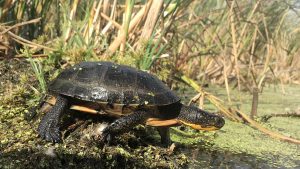 We are hiring 6 people to help collect data to aid in conservation of Illinois amphibians and reptiles. Technicians will work on two projects, collecting demographic data on the federally threatened Eastern Massasauga and state endangered Blanding’s Turtle.
We are hiring 6 people to help collect data to aid in conservation of Illinois amphibians and reptiles. Technicians will work on two projects, collecting demographic data on the federally threatened Eastern Massasauga and state endangered Blanding’s Turtle.
Starting salary is $15 per hour; up to 40 hours per week. 3 positions will start on or before March 1, 2022, and 3 positions will start on April 1, 2022. 4 positions will end on October 30, 2022, and 2 will end on November 31, 2022.
Five year, $6 million contract awarded to UBAP team
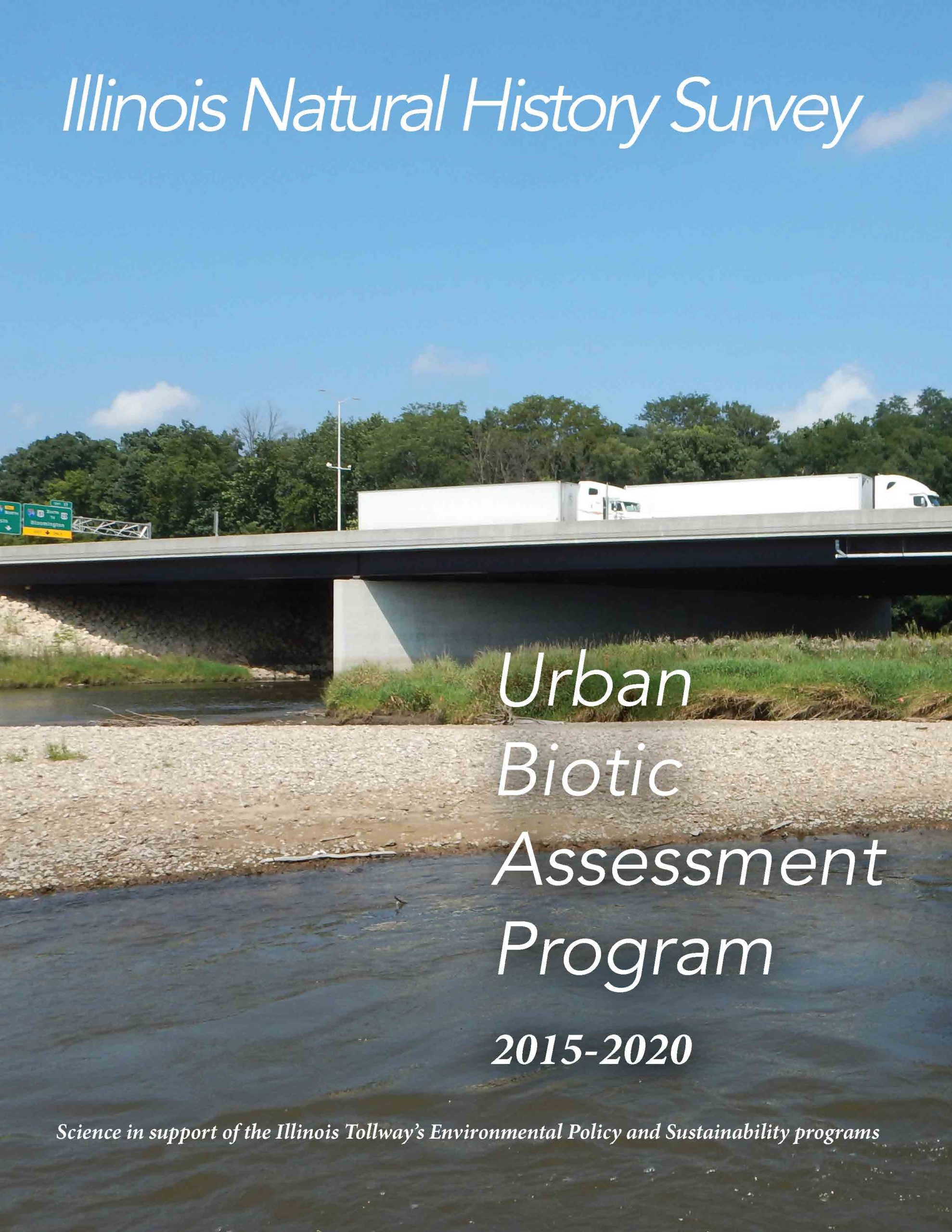 The Urban Biotic Assessment Program was awarded $6,226,400 to continue providing technical assistance to the Illinois Tollway Environmental team.
The Urban Biotic Assessment Program was awarded $6,226,400 to continue providing technical assistance to the Illinois Tollway Environmental team.
This is the third intergovernmental agreement between the INHS and the Illinois Tollway and will allow the continuation of this mutually beneficial partnership that began in 2005.
The partnership has grown from monitoring Blanding’s Turtles in the Des Plaines River Valley to a multi-disciplinary program. While the key function is to provide the ecological knowledge necessary to comply with state and federal regulations, both organizations share a goal of studying the natural resources of the region to protect them into the future.
Research projects in this new agreement include biotic surveys of each of the Tollway corridors, continuation of longterm monitoring of the Kishwaukee River mussel population, using eDNA to detect cryptic species, Rusty Patched Bumble Bee surveys, and identifying bat roost trees.
Download our report of activities from 2015-2020
PACE Lab researchers awarded two Competitive State Wildlife Grants
Two projects from the INHS PACE Lab were among the 21 projects funded nationally by the 2021 U.S. Fish and Wildlife Service’s Competitive State Wildlife Grant (C-SWG) program.
 The first cooperative project is with the Iowa and Illinois Department of Natural Resources, allocated at $499,797 for the joint project titled “Blanding’s Turtle Conservation in Iowa and Illinois, 2022 through 2024”. The project team from the Illinois Natural History Survey (INHS) and National Great Rivers Research and Education Center (NGREEC) comprises Ethan J. Kessler, Michael J. Dreslik, Andrew R. Kuhns, and John A. Crawford. The team was awarded $249,449 for their portion of the project, “Population Assessment and Space Use in a Kankakee Sands Region Blanding’s Turtle Population.” While much work has been done on Blanding’s Turtle populations in the Chicagoland region, this project focuses on lesser-known populations in the Kankakee Sands Conservation Opportunity Area.
The first cooperative project is with the Iowa and Illinois Department of Natural Resources, allocated at $499,797 for the joint project titled “Blanding’s Turtle Conservation in Iowa and Illinois, 2022 through 2024”. The project team from the Illinois Natural History Survey (INHS) and National Great Rivers Research and Education Center (NGREEC) comprises Ethan J. Kessler, Michael J. Dreslik, Andrew R. Kuhns, and John A. Crawford. The team was awarded $249,449 for their portion of the project, “Population Assessment and Space Use in a Kankakee Sands Region Blanding’s Turtle Population.” While much work has been done on Blanding’s Turtle populations in the Chicagoland region, this project focuses on lesser-known populations in the Kankakee Sands Conservation Opportunity Area.
The grant will facilitate an intensive capture-mark-recapture study to determine population size and begin to collect demographic data. A subset of turtles will be tracked using radio telemetry and GPS trackers to monitor survival and determine space and habitat use. The data is necessary to determine the amount and extent of suitable habitat available on the landscape and address causes of mortality for this population. The work will build on previous research on Blanding’s Turtles in Illinois and further inform conservation planning.
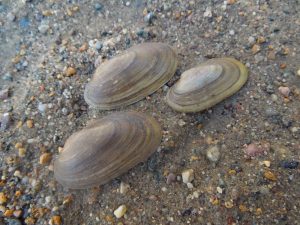 The second cooperative project is with the Minnesota Department of Natural Resources allocated at $247,892 for the joint project titled, “Regional Assessment of Widespread Mussel Declines: a Multistep Approach to Examine Potential Causes.” The project team from the INHS comprises Sarah A. Douglass and Alison P. Stodola while INHS alum Bernard Sietman will lead Minnesota’s portion. The INHS team was awarded $113,364 for their portion of the project. Freshwater mussels, an ecologically important component of river ecosystems, are experiencing widespread declines. With the award, Douglass and Stodola will investigate potential causes for these declines with the goal of informing conservation guidelines and recovery planning. Additionally, this study is an expansion of a largescale, cooperative project spearheaded by Dr. Wendell Haag, US Forest Service Research Fisheries Biologist, and American Rivers to examine causes of freshwater mussel declines across North America.
The second cooperative project is with the Minnesota Department of Natural Resources allocated at $247,892 for the joint project titled, “Regional Assessment of Widespread Mussel Declines: a Multistep Approach to Examine Potential Causes.” The project team from the INHS comprises Sarah A. Douglass and Alison P. Stodola while INHS alum Bernard Sietman will lead Minnesota’s portion. The INHS team was awarded $113,364 for their portion of the project. Freshwater mussels, an ecologically important component of river ecosystems, are experiencing widespread declines. With the award, Douglass and Stodola will investigate potential causes for these declines with the goal of informing conservation guidelines and recovery planning. Additionally, this study is an expansion of a largescale, cooperative project spearheaded by Dr. Wendell Haag, US Forest Service Research Fisheries Biologist, and American Rivers to examine causes of freshwater mussel declines across North America.
Researchers will assess pairs of rivers with similar historic mussel assemblages, comparing a river with relatively intact mussel assemblages and a river with a degraded assemblage. They will develop health metrics and assess habitat characteristics to identify potential causal factors of decline. Juvenile mussels will be propagated and used to assess health in response to potential causes of decline. Another part of the project will use eDNA and targeted sampling to update knowledge of Salamander Mussel populations in Illinois and Minnesota. The research will build on a pilot project previously undertaken by Douglass to use eDNA to detect the critically imperiled species and its host, the Mudpuppy salamander.
In granting these awards, USFWS recognizes the necessity of these two projects to further the goals of the Illinois Wildlife Action Plan to conserve imperiled species and their habitats.
INHS PACE Lab on Will County’s “The Buzz”
INHS PACE Lab hired their furry four-legged turtle sniffers again this year to help at sites across Illinois. Their skill at locating endangered Ornate Box Turtles was featured on the latest episode of The Forest Preserve District of Will County’s “The Buzz”
Ornate Box Turtles at 2021 Virtual Nachusa Science Symposium
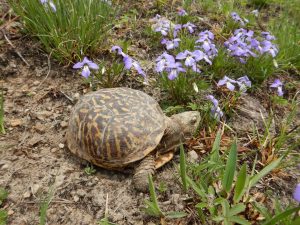 PACE Lab PhD candidate Devin Edmonds participated in the Nachusa Grasslands Science Symposium on April 24th. He presented “An Update on Ornate Box Turtle (Terrapene ornata) Research at Nachusa Grasslands,” work he did for his M.S. studying the state threatened Ornate Box Turtle. Learn more about his research and findings.
PACE Lab PhD candidate Devin Edmonds participated in the Nachusa Grasslands Science Symposium on April 24th. He presented “An Update on Ornate Box Turtle (Terrapene ornata) Research at Nachusa Grasslands,” work he did for his M.S. studying the state threatened Ornate Box Turtle. Learn more about his research and findings.
UBAP ornithologist wins Best Poster Award
UBAP ornithologist Asya Rahlin presented a poster “Spatial and temporal drivers of marsh bird occupancy in an urbanized matrix” at the Natural Resources and Environmental Sciences Symposium and earned the award for Best Poster.
Read more about Asya’s research
2021 NRES Symposium
PACE Lab graduate students presented at the Natural Resources and Environmental Sciences Symposium, April 17th, 2021.
-
- Alma C. Schrage presented “Bumble Bee Detection and Occupancy in Northern Illinois” Click for more info
- Devin Edmonds presented “Informing the Mantella cowanii Conservation Action Plan” Click for more info
- Anastasia Rahlin presented “Spatial and temporal drivers of marsh bird occupancy in an urbanized matrix” Click for more info
- Tyler Stewart presented “Distribution and Detection Probability for Kirtland’s Snake (Clonophis kirtlandii)” Click for more info
